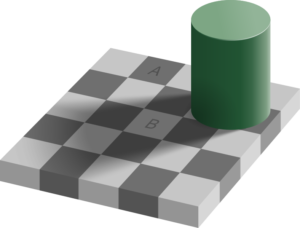Optical illusions have long been a source of interest for many years.
Among his renowned academic interests, Joseph Jastrow was noted for his work on optical illusions. His landmark paper on the subject ‘A Study of Zöllner’s Figures and Other Related Illusions‘ was published in ‘The American Journal of Psychology’ in April 1892.
Joseph Jastrow was instrumental in popularizing psychological science among the general public and regularly wrote for leading magazines such as Popular Science Monthly, including an article in 1899 titled ‘The mind’s eye’ which featured the rabbit–duck illusion shown below.

An eminent experimental psychologist and renowned historian of psychology, Edwin Boring was also known for his influential work on visual perception, in particular ambiguous illusions; such as the ubiquitous young woman, old woman figure.

Shades of Gray

Square A and B really are the same shade of gray. This incredible illusion was created by Edward H. Adelson, Professor of Vision Science in the department of Brain and Cognitive Sciences at the Massachusetts Institute of Technology. According to Professor Adelson, the illusion is a product of your visual system attempting…
to determine where the shadows are and how to compensate for them, in order to determine the shade of gray ‘paint’ that belongs to the surface.
Square B sits in the shadow of the cylinder, Square A does not and your perceptual field has evolved to automatically correct changes in the appearance of a color when it is in shadow. A great explanation as to why squares A and B appear so visually different has been offered by Richard Wiseman, Professor of the Public Understanding of Psychology at the University of Hertfordshire.
Your eyes and brain see that the two squares are the same shade of gray, but then think, ‘Hold on – if a square in a shadow reflects the same amount of light as a square outside of the shadow, then in reality it must be a much lighter shade of gray.’ As a result, your brain alters your perception of the image so that you see what it thinks is out there in the real world.
Dynamic Illusions
Check out new “dynamic” versions of optical illusions at the Expect the Unexpected site.

